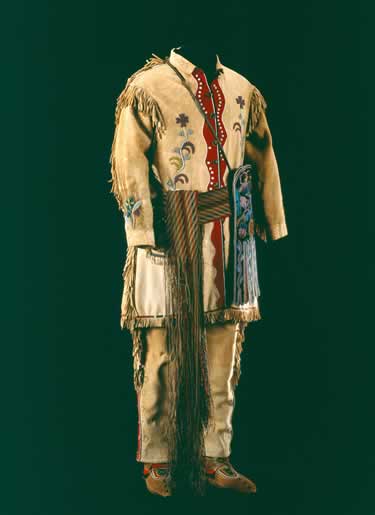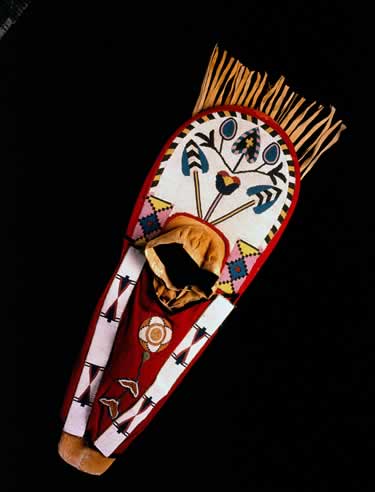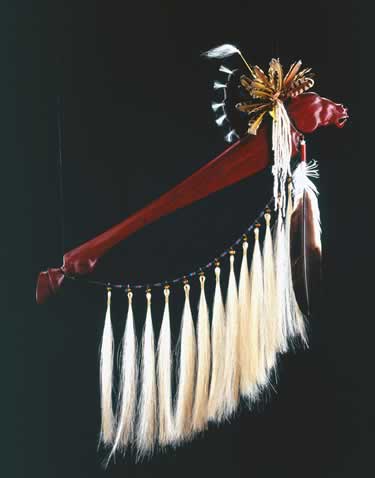|
 The
artistry, history and poetry of Native American cowboy life will be presented
in “Legends of Our Times: Native Ranching and Rodeo Life on the Plains
and the Plateau at the Smithsonian's National Museum of the American Indian
in Lower Manhattan, on Saturday, May 17. More than 700 objects, such as
saddles, photographs, blankets, clothing, horse gear and powwow regalia,
will be included in the exhibition, which will continue at the museum
through March 7, 2004. The
artistry, history and poetry of Native American cowboy life will be presented
in “Legends of Our Times: Native Ranching and Rodeo Life on the Plains
and the Plateau at the Smithsonian's National Museum of the American Indian
in Lower Manhattan, on Saturday, May 17. More than 700 objects, such as
saddles, photographs, blankets, clothing, horse gear and powwow regalia,
will be included in the exhibition, which will continue at the museum
through March 7, 2004.
"Legends
of Our Times" traces the history of Native people as buffalo hunters,
horsemen, ranchers, and cowboys, and as entertainers and participants
in the sport of rodeo. The exhibition begins by presenting the connections
between traditional Plains and Plateau cultures and such animals as the
horse, the buffalo and the dog—and how these connections influenced
the Native cowboy's perspective on ranching and rodeo life.
Challenging
the stereotype of "cowboys and Indians," the exhibition continues
with Native American contributions to ranching, rodeo culture, Western
entertainment and cowboy arts.
Highlights
of the exhibition include a late 19th-century rifle case embellished with
porcupine quill embroidery; an elaborately beaded Kootenai cradle board
that could be attached to the side of a saddle and probably was part of
a woman's parade outfit; a buffalo hunter's outfit from the mid-1800s,
decorated with glass beads and embroidery; an elegant horse dance stick
by Dennis R. Fox Jr. (Nueta/Hidatsa/Lakota); and historical and contemporary
photographs of Native cowboy life.
"The
National Museum of the American Indian is delighted to present this groundbreaking
exhibition, and to recognize the important contributions made by Native
Americans to rodeo and ranching culture," said museum Director W.
Richard West (Southern Cheyenne).
 After
the Civil War, when Texas was cut off from its eastern markets, able-bodied
horsemen were required for the massive cattle drives from Texas to Missouri,
California, Kansas, Montana, Illinois and North Dakota. Many Native people
were among these early cowboys, adapting their experiences driving herds
of buffalo and deer, equestrian skills and knowledge of the territories
used for cattle grazing. By the mid-19th century, many Native people took
advantage of new economic opportunities in the emerging ranching industry
and established their own ranches. Other Native Americans, faced with
depleted buffalo herds, limited resources and government policies and
restrictions, were forced to leave their traditional way of life and find
work as cowboys. In the late 19th century, when cowboy skills became forms
of entertainment and sport, Native people expressed their skills and elements
of their cultures as actors in "Wild West" shows and as competitors
in professional rodeos. The popularity of rodeos also grew within Native
communities and continues today. After
the Civil War, when Texas was cut off from its eastern markets, able-bodied
horsemen were required for the massive cattle drives from Texas to Missouri,
California, Kansas, Montana, Illinois and North Dakota. Many Native people
were among these early cowboys, adapting their experiences driving herds
of buffalo and deer, equestrian skills and knowledge of the territories
used for cattle grazing. By the mid-19th century, many Native people took
advantage of new economic opportunities in the emerging ranching industry
and established their own ranches. Other Native Americans, faced with
depleted buffalo herds, limited resources and government policies and
restrictions, were forced to leave their traditional way of life and find
work as cowboys. In the late 19th century, when cowboy skills became forms
of entertainment and sport, Native people expressed their skills and elements
of their cultures as actors in "Wild West" shows and as competitors
in professional rodeos. The popularity of rodeos also grew within Native
communities and continues today.
"Legends
of Our Times: Native Ranching and Rodeo Life on the Plains and the Plateau"
is a traveling exhibition produced by the Canadian Museum of Civilization
and curated by Morgan Baillargeon and Leslie Tepper. A catalog, by Baillargeon
and Tepper, accompanies the exhibition.
The
presentation at the Smithsonian's National Museum of the American Indian
was organized by Dr. Gerald McMaster (Plains Cree), Deputy Assistant Director
for Cultural Resources; Peter Brill, Head of Exhibits for the George Gustav
Heye Center; and Exhibits Manager Jennifer Tozer.
The
National Museum of the American Indian's George Gustav Heye Center is
located at One Bowling Green in New York City, across from Battery Park.
The museum is free and open every day from 10 a.m. to 5 p.m.; and Thursdays
until 8 p.m. For information, call (212) 514-3700 for general information
and (212) 514-3888 for a recording about the museum's public programs.
By subway, the museum may be reached by the 1 or 2 to South Ferry, the
4 or 5 to Bowling Green or the N or R to Whitehall Street.
Legends
of Our Times Exhibit
"Legends of Our Times" traces
the history of Native people as buffalo hunters, horsemen, ranchers,
and cowboys, and as entertainers and participants in the sport
of rodeo. The exhibition begins by presenting the connections
between traditional Plains and Plateau cultures and such animals
as the horse, the buffalo and the dog—and how these connections
influenced the Native cowboy's perspective on ranching and rodeo
life.
http://www.conexus.si.edu/legends/main.html
|
|
|


![]()


